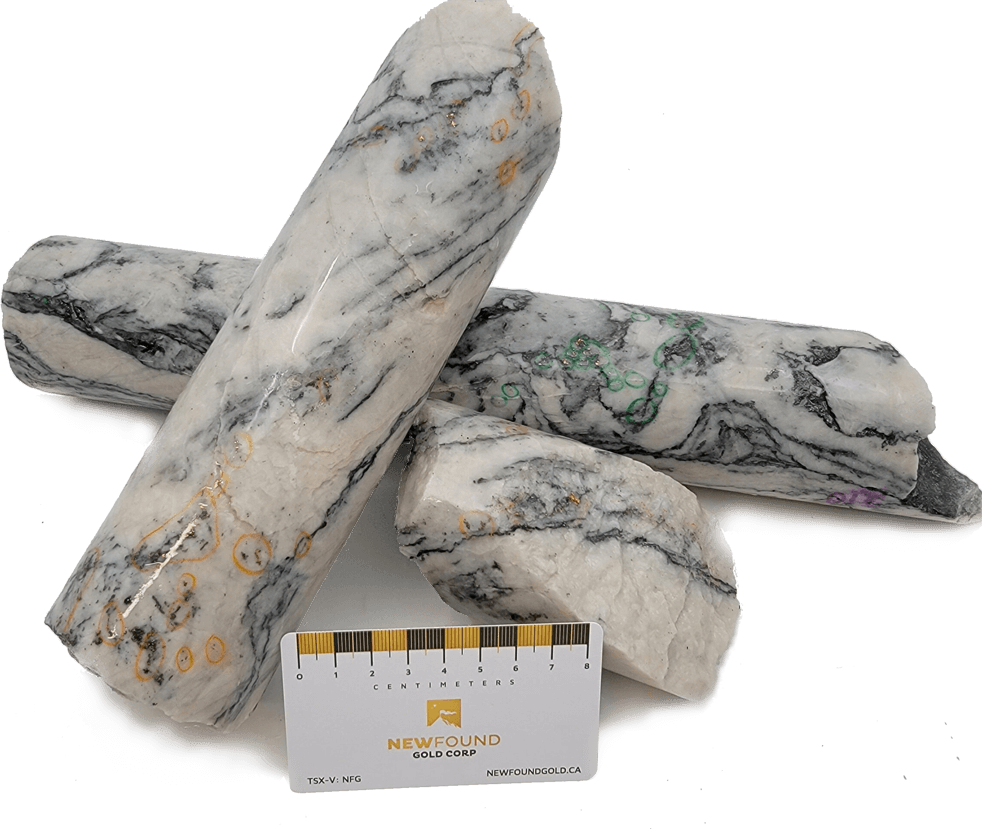Vancouver, British Columbia–(Newsfile Corp. – August 12, 2020) – New Found Gold Corp. (TSXV: NFG) (“New Found” or the “Company“) is pleased to announce an update on corporate activities and on its ongoing exploration activities at its Queensway Project, located in Central Newfoundland.
Highlights:
- As previously announced, New Found has successfully completed its IPO led by Canaccord Genuity and BMO Nesbitt Burns issuing an aggregate of 21,000,000 common shares at a price of $1.30 per share for total gross proceeds of C$27,300,000.
- Post the IPO and prior to any exercise of the over-allotment option, New Found has 138.8 million shares issued and working capital of C$72 million (including 6.94 million Novo Resources shares priced at August 10 close).
- 90.1 million shares are subject to escrow or 180-day lock up agreements. There are 1,298,632 broker warrants issued and no other outstanding warrants.
- The Company has a strong and supportive shareholder base including Palisades Goldcorp (33%), Eric Sprott (18%), Novo Resources (11%), Rob McEwen (7%), additional institutional ownership (8%), and management and insiders (4%).
- New Found is the largest mineral claimholder in the Province of Newfoundland & Labrador. The Company is fully funded for its Phases 1 and 2 drilling program at Queensway totaling 100,000 meters, budgeted at C$21.6 million and targeted for completion by the end of 2021.
- Details on the Company’s Queensway project and exploration plans are provided in the Company’s prospectus dated July 31, 2020 and filed on SEDAR.
Collin Kettell, Executive Chairman of New Found stated: “After five years of privately funded exploration expenditures in excess of $10 million, we have now advanced the Queensway Project to an exciting stage where we are a listed company. A 100,000 m drill program will be initiated shortly, backed by $72 million in working capital. In late 2019, we intercepted 19.0 m of 92.9 g/t gold in the first hole of our maiden drill program at Queensway. We are excited to be embarking on this major drill program to follow up on this interval and to test the multiple targets as summarized in our prospectus.”
Craig Roberts, P.Eng., Chief Executive Officer stated: “We appreciate the support and trust the investment community has placed in our board, management team and exploration crews and we will work hard to execute our programs with effectiveness and efficiency. New Found will deliver a steady stream of drill results to the market through the planned 12+ months Phase 1 and Phase 2 programs. We would like to thank all of our stakeholders, including the communities of Gander and Appleton, as well as the local and provincial government representatives in Newfoundland for the support they have provided. We look forward to working together with all stakeholders as we advance the Queensway project through this next exciting phase of exploration.”
Ongoing Exploration Activity
An extensive program of field work began at the Queensway project in June and is ongoing, with a crew of more than 30 geologists, prospectors, and support personnel on site. The Company has been conducting a large-scale regional reconnaissance program at Queensway South, mapping geology, structure, and mineralization. The Company is also conducting an extensive till sampling program to further refine the gold in till anomalies discovered in 2018. These till anomalies all lie outside of areas with known gold occurrences.
An aggressive plan of surface excavation at Queensway North has been ongoing and has exposed and expanded several of the historic gold showings along the Appleton fault zone. It has also led to the discovery of two new zones of surface mineralization. The goal of this work is to further evaluate the surface showings, mineralization, and structure and best prepare for the upcoming drilling program.
The Company is actively preparing sites for drill pads in anticipation of launching a major drill program. This drilling will include closely spaced follow up to hole NFGC-19-01 at the Keats Zone, which intersected 19.0 m of 92.9 g/t gold starting at 96 m down. This intercept has an estimated true width of 70%, with further details regarding this hole provided in the table below.

Highlights of the Queensway Project
Advantageous Location: New Found’s Queensway project is located on the Trans-Canada Highway, a 15-minute drive west of Gander, Newfoundland. A network of maintained forestry roads crisscross the project and provide excellent access for year-round exploration and drilling. The high-grade discovery hole at Keats (NFGC 19-01) is located less than 1 km from the highway.
The nearby Town of Gander has a population of 14,000, an international airport, and several industrial supply and support services. A significant number of the geologists and prospectors employed by the Company reside in Gander. Basing out of Gander has facilitated the Company’s strategy to minimize Covid-19 risks. Permitting is straight forward and the Government of Newfoundland and Labrador is supportive of mining development.
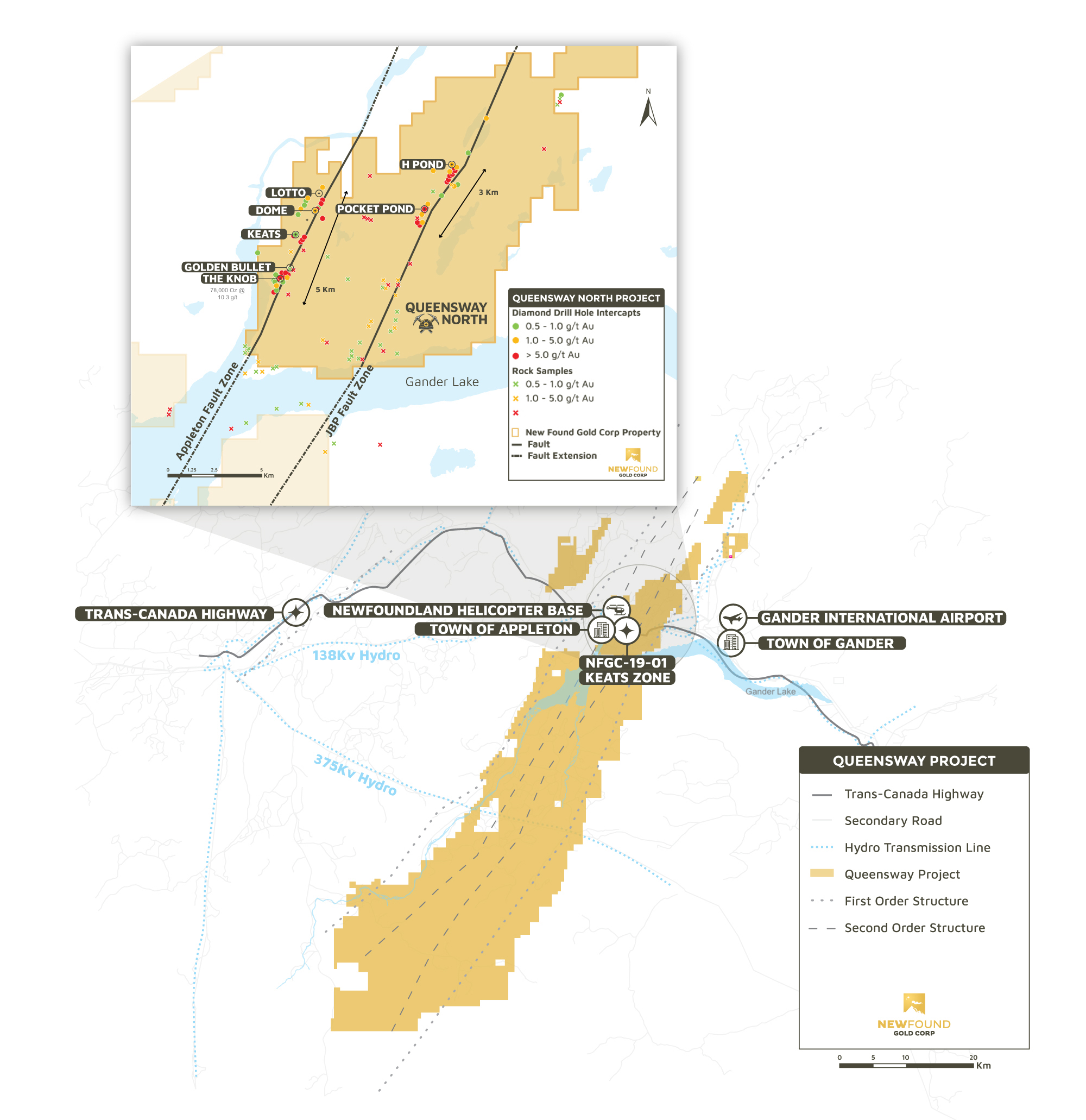
Figure 1
District Scale: Typically, major gold districts occur on deep, extensive fault or fracture systems that tap into gold-rich magmatic fluids at depth. The Queensway project is located on an approximately 105 km long NE-SW trending section of a fracture zone created through the collision of the North American and African plates approximately 450 million years ago. The Appleton and JBP fault structures are deep seated gold mineralizing structures created in this collision event (see figure below).

Figure 2
The 5 km of strike along the Appleton Fault Zone and the 3 km along the JBP Fault Zone that is the initial focus of drilling (see figure) is a small portion of the +100 km of prospective structure on these faults. An extensive till survey conducted by New Found over the last several years has identified approximately six large gold in soil anomalies coincident with the Appleton and JBP faults (see teal areas on the figure above). Some of these anomalies are up to 5 km in length and several km in width. The Phase 1 work includes additional till sampling on tighter line spacing, followed by trenching and drilling.
High Grade, Near Surface Targets: All drilling to date has been shallow, almost all of it to less than 100 m of depth. The surface sampling and drill intercepts in the figure below illustrate the high-grade nature of the gold mineralization. Along with this sampling and drilling work, high resolution geophysics, detailed structural mapping, till sampling, and trenching have been key in defining the initial drill target areas.
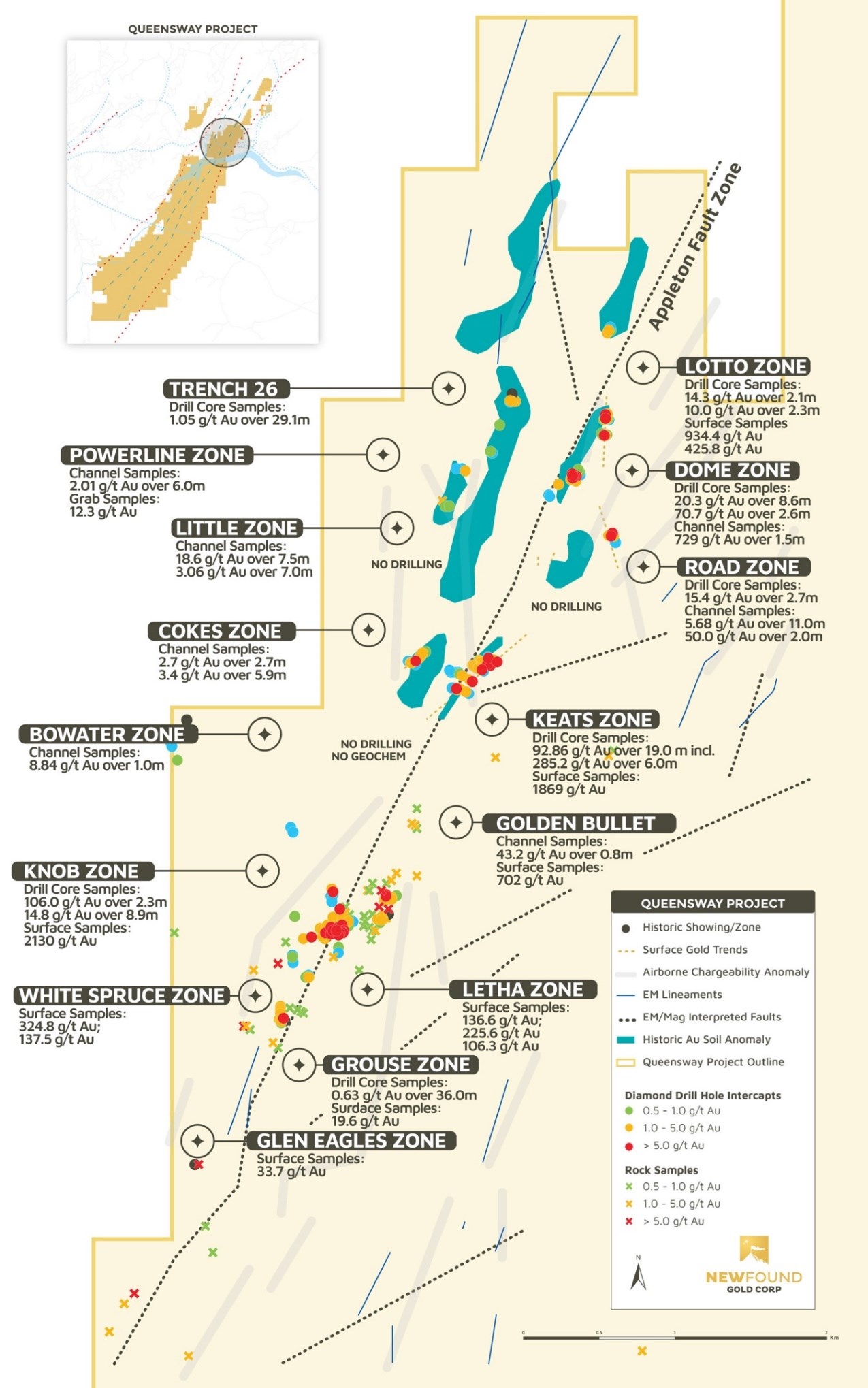
Figure 3
The high-grade and shallow nature of the mineralization means that the initial target areas can be tested with relatively shallow holes, resulting in relatively low drilling costs and shorter times for hole completion. The orogenic style mineralization has potential to extend to significant depth and the Company anticipates that drill hole lengths will increase over time as the Company pursues gold mineralization to depth.
Epizonal Style Mineralization: The mineralization in the 19.0 m at 92.9 g/t gold intercept at Keats Zone is now interpreted as epizonal style gold mineralization similar to that found at the high-grade Swan Zone at Kirkland Lake Gold’s Fosterville mine in Victoria, Australia. This similarity was recognized by Dr. Quinton Hennigh during his initial review and site visit in January 2020. Dr. Hennigh previously completed significant due diligence on the Swan Zone for Kirkland Lake Gold. Epizonal type of mineralization is emplaced near surface when a rock fracture perhaps due to a seismic event taps into very high temperature and pressure gold rich magmatic fluids at depth. These fluids move to surface in an explosive event and gold is precipitated rapidly as the fluid temperature and pressure suddenly drops. There are certain mineralogical and textural signatures of this epizonal type of mineralization. The Keats high-grade gold mineralization at Queensway is visually almost identical to that found in the Fosterville Swan Zone. An example is the “pin prick” very fine visible gold that results from the rapid gold precipitation. Additional detail on this comparison can be found on the corporate presentation and in the Addendum to this press release.

Figure 4
Left, core from Keats zone, Queensway Project; right, core from the Eagle zone, Fosterville Mine. Comparison of gray and white quartz vein material with numerous small specks of native gold from each deposit. Grey specks are mostly antimony minerals, boulangerite on the left and stibnite on the right. Some gray flecks are particles of black shale caught up in quartz. Such fine gold particles likely formed through rapid precipitation of gold in a shallow epizonal regime within an orogenic system, an indication of a shallow level of deposition for both deposits.
Note that the photos above and the Addendum to this release are of selected intervals and are not necessarily representative of the mineralization hosted on the Queensway property.
To the Company’s knowledge drilling along the JBP fault including by Rubicon in the mid-2000’s has not yet intersected epizonal style high-grade gold mineralization. However a high grade surface boulder (798 g/t) recovered to the north of the historic drilling at JBP provides some evidence that the JBP fault is also prospective for epizonal type gold mineralization. New Found will utilize its new understanding of the epizonal genetic model to explore for this type of epizonal mineralization along the JBP Fault Zone.
Board and Management
The Board of Directors and management team of the Company have been reconstituted to include the following individuals:
Collin Kettell – Founder & Executive Chairman: Collin is the Founder & Executive Chairman of Palisades Goldcorp Ltd., Canada’s new resource focused merchant bank, with $220M AUM and growing. He comes from a family with deep ties to the mining industry, including co-founding AuEx Ventures, the company responsible for discovering the Long Canyon deposit, a project ultimately acquired by Newmont for $2.3B. Collin is the Founder & Executive Chairman of Nevada King Mining Ltd., the fifth largest mineral claim holder in the State of Nevada; Co-Founder & CEO of Victory Metals; and Co-Founder of Goldspot Discoveries.
Craig Roberts, P.Eng. – Chief Executive Officer & Director: Craig is a mining engineer with over 30 years of operations, consulting and investment banking experience. Includes work on feasibility studies for numerous mining projects worldwide, investment banking/due diligence roles in over 200 institutional equity financings. Significant experience advising management and boards on merger and acquisition transactions. Mr. Roberts has a degree in Mining Engineering from the University of British Columbia and an M.Phil. in Management Studies from Oxford University.
Denis Laviolette – Founder, President & Director: Denis has 10 years of experience in mining and capital markets; worked as a production and exploration geologist in Timmins, Kirkland Lake, Red Lake, Norway and Ghana. Later worked as a mining analyst with Pinetree Capital. Founder, Director and Executive Chairman of Goldspot Discoveries Inc. and also currently serves as a Director for Xtra-Gold Resources Corp.
Dr. Quinton Hennigh, P.Geo. – Director: Quinton is an economic geologist with 25 years of exploration experience, mainly gold related. Led exploration teams for Homestake Mining Company, Newcrest Mining Ltd. and Newmont Mining Corp. Founder, Chairman and President of Novo Resources, Founder and Director of Irving Resources. Lead role in a number of discoveries including significant involvement in high grade Swan Zone discovery at Fosterville.
John Anderson – Director: John has over 25 years of capital market experience specializing in the resource sector. A founder and financier of a number of startup companies with experience on the TSX. NYSE, NASDAQ, London AIM and Swiss Stock exchanges; Founder of Deep 6 PLC, American Eagle Oil and Gas,Inc. Founding general partner in Aquastone Capital LLC. Executive Chairman of Triumph Gold Corp. and Chairman of EXM Farming Corp.
Greg Matheson, P.Geo. – Chief Operating Officer: Greg is a professional geologist with over 14 years experience managing grass roots exploration through to advanced exploration projects; former exploration manager of Northern Gold Mining, senior project manager for Oban Mining and Osisko Mining. Responsible for the discovery and delineation of the >2.0 Moz. Garrison Gold project in NE Ontario from early stage exploration through trial production mining.
Michael Kanevsky, CPA, CA – Chief Financial Officer: Michael is a Chartered Professional Accountant with expertise in corporate reporting, financial processes and risk management. Began his professional career in the audit and assurance practice at Deloitte and is the CFO of Mexican Gold Corp., Palisades Gold Corp. and several private mining companies.
Ken Rattee – V.P. Exploration: Ken has over 36 years’ experience in base and precious metal mineral exploration in various management roles; former chief geologist for Kirkland Lake Gold’s Macassa Mine. Extensive experience developing, supervising and implementing exploration campaigns including for Lac Minerals, Kirkland Lake Gold, Kinross Gold and Barrick Gold.
Option Grant
New Found announces that it has granted stock options exercisable for a total of 5,040,000 common shares in the capital of the Company, to certain officers, directors, employees, and consultants of the Company. These stock options have an exercise price of $1.40 per option and expire on August 12, 2025. The options are governed by the terms and conditions of the Company’s Amended and Restated Stock Option Plan. Following the grant of the stock options, the Company has a total of 13,830,000 stock options outstanding, representing approximately 9.96% of the outstanding common shares of the Company. This stock option grant is subject to TSX Venture Exchange approval.
QA/QC
True widths of the new exploration intercepts reported in this press release have yet to be determined but are estimated to be 70% of reported core lengths. Additional drilling is planned for the immediate area which will enable the true width determination. Assays are uncut, and calculated intervals are reported over a minimum length of 2 metres using a lower cutoff of 3.0 g/t Au. All HQ core assays reported were obtained by either whole sample rock metallic screen/fire assay or standard 30-gram fire-assaying with ICP finish at ALS Minerals in Vancouver, British Columbia. The whole sample metallic screen assay method is selected by the geologist when samples contain coarse gold or any samples displaying gold initial fire assay values greater than 1.0 g/t Au. Drill program design, Quality Assurance/Quality Control and interpretation of results is performed by qualified persons employing a Quality Assurance/Quality Control program consistent with NI 43-101 and industry best practices. Standards and blanks are included with every 20 samples for Quality Assurance/Quality Control purposes by the Corporation as well as the lab. Approximately 5% of sample pulps are sent to secondary laboratories for check assays.
Qualified Person
The technical content disclosed in this press release was reviewed and approved by Greg Matheson, P.Geo., Chief Operating Officer and a Qualified Person as defined under National Instrument 43-101.
About New Found Gold Corp
New Found holds a 100% interest in the Queensway Project, located 15 km west of Gander, Newfoundland. The project is intersected by the Tran’s Canada Highway, is located just 18 km from Gander international airport, has logging roads crosscutting the project, has high voltage electric power lines running through the project area, and easy access to a highly skilled workforce. The Company is well financed for aggressive exploration with an initial planned drill program of 100,000 meters. New Found has a proven capital markets and mining team with major shareholders include Palisades Goldcorp (33%), Eric Sprott (18%), Novo Resources (11%), Rob McEwen (7%), other institutional ownership (8%), and management, directors and insiders (4%). Approximately 65% of the Company’s issued and outstanding shares are subject to escrow or 180-day lock up agreements.
Please see the Company’s website at www.newfoundgold.ca and the Company’s SEDAR profile at www.sedar.com.
Contact
To contact the Company please visit the Company’s website, www.newfoundgold.ca and make your request through our investor inquiry form. Our management has a pledge to be in touch with any investor inquiries within 24 hours.
New Found Gold Corp.
Per: “Craig Roberts”
Craig Roberts, P.Eng., Chief Executive Officer
croberts@newfoundgoldcorp.ca
Neither the TSX Venture Exchange nor its Regulation Services Provider (as that term is defined in the policies of the TSX Venture Exchange) accepts responsibility for the adequacy or accuracy of this release.
Forward-Looking Statement Cautions:
This press release contains certain “forward-looking statements” within the meaning of Canadian securities legislation, relating to further the exploration and drilling on the Company’s Queensway gold project in Newfoundland. Although the Company believes that such statements are reasonable, it can give no assurance that such expectations will prove to be correct. Forward-looking statements are statements that are not historical facts; they are generally, but not always, identified by the words “expects,” “plans,” “anticipates,” “believes,” “intends,” “estimates,” “projects,” “aims,” “potential,” “goal,” “objective,” “prospective,” and similar expressions, or that events or conditions “will,” “would,” “may,” “can,” “could” or “should” occur, or are those statements, which, by their nature, refer to future events. The Company cautions that Forward-looking statements are based on the beliefs, estimates and opinions of the Company’s management on the date the statements are made and they involve a number of risks and uncertainties. Consequently, there can be no assurances that such statements will prove to be accurate and actual results and future events could differ materially from those anticipated in such statements. Except to the extent required by applicable securities laws and the policies of the TSX Venture Exchange, the Company undertakes no obligation to update these forward-looking statements if management’s beliefs, estimates or opinions, or other factors, should change. Factors that could cause future results to differ materially from those anticipated in these forward-looking statements include risks associated possible accidents and other risks associated with mineral exploration operations, the risk that the Company will encounter unanticipated geological factors, the possibility that the Company may not be able to secure permitting and other governmental clearances necessary to carry out the Company’s exploration plans, the risk that the Company will not be able to raise sufficient funds to carry out its business plans, and the risk of political uncertainties and regulatory or legal changes that might interfere with the Company’s business and prospects. The reader is urged to refer to the Company’s reports, publicly available through the Canadian Securities Administrators’ System for Electronic Document Analysis and Retrieval (SEDAR) at www.sedar.com for a more complete discussion of such risk factors and their potential effects.
ADDENDUM
Comparison of Queensway and Fosterville Swan Zone Geology and Mineralization
While no two mineral systems are ever identical, there is strong evidence to suggest the Central Newfoundland Gold Belt has many similarities to the Bendigo goldfields in Victoria state, Australia which New Found Gold is using as an early geological model. Bendigo goldfields has produced over 22 Moz of gold over its >150yr mining history. Fosterville Mine (Kirkland Lake Gold) is currently in production as the world’s highest grade and one of the lowest-cost primary gold mines.

Figure 5

Figure 6
Left, core from the Keats zone, Queensway Project; right, core from the Eagle zone, Fosterville Mine. Comparison of intense quartz stock work with relict black shale fragments from each deposit. Specks of visible gold are present in quartz veins and their selvages. Gray patches contain fine grained antimony sulfides, boulangerite on left and stibnite on right.
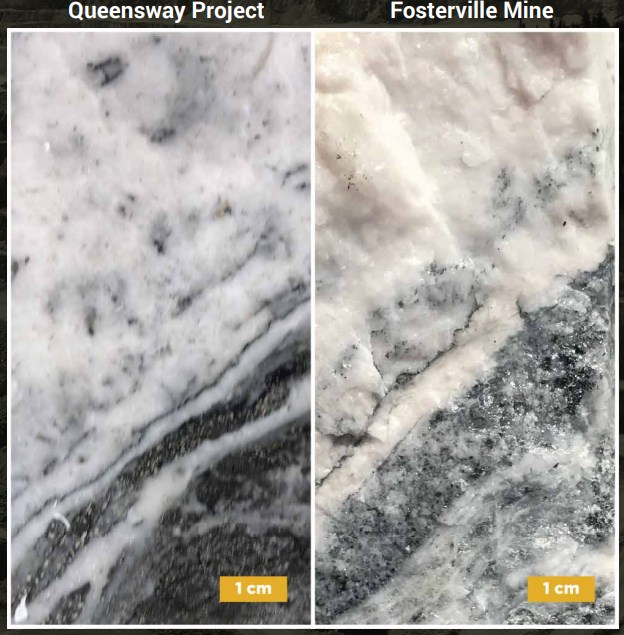
Figure 7
Left, core from the Keats zone, Queensway Project; right, hand specimen from the Eagle zone, Fosterville Mine. Comparison of quartz veining displaying relict banding from each deposit. Dark material at the bottom is relict shaley material. Such banding is probably an original texture resulting from open space filling of quartz sulfides and gold at the time of deposition. Open space filling is indicative of a shallow level of deposition for both deposits.

Figure 8
Left, core from Keats zone, Queensway Project; right, core from the Eagle zone, Fosterville Mine. Comparison of vein quartz displaying numerous vugs, or small cavities, lined with quartz crystals from each deposit. Native gold is also visible in each sample. Such open space cavities are indicative of a shallow level of deposition for both deposits.
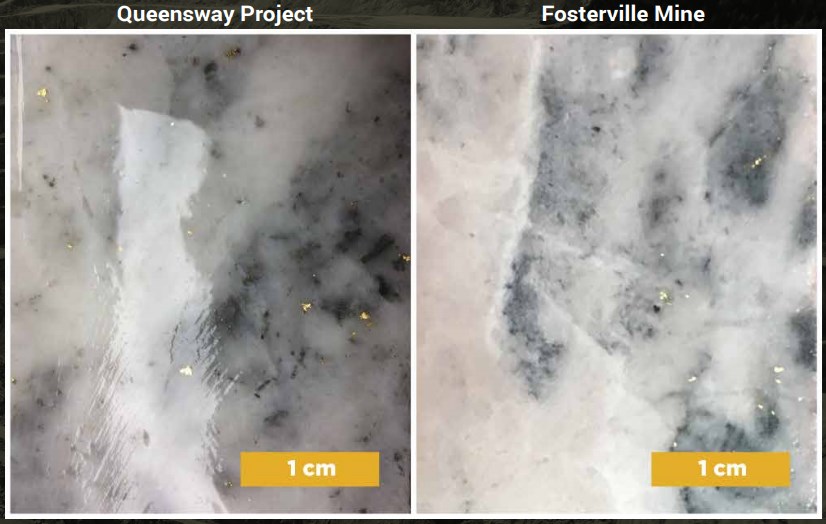
Figure 9
Left, core from Keats zone, Queensway Project; right, core from the Eagle zone, Fosterville Mine. Comparison of gray and white quartz vein material with numerous small specks of native gold from each deposit. Grey specks are mostly antimony minerals, boulangerite on the left and stibnite on the right. Some gray flecks are particles of black shale caught up in quartz. Such fine gold particles likely formed through rapid precipitation of gold in a shallow epizonal regime within an orogenic system, an indication of a shallow level of deposition for both deposits.

